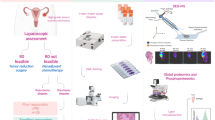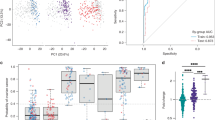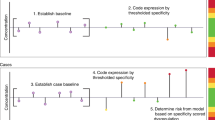Abstract
A study has been carried out to investigate the cellular distribution and levels of glutathione-S-transferase isoenzymes (GST), acidic (pi), basic (alpha) and neutral (mu), in ovarian tumour biopsies, and to measure GST activity in the same tumour specimens. Two methods of assessing isoenzyme levels (immunohistochemistry and Western blot) were compared. Well-known important clinicopathological features were correlated with response to treatment, overall survival and progression-free survival for each of 97 patients from whom biopsies had been obtained. The glutathione-S-transferase isoenzyme levels were also correlated with overall and progression-free survival, and with the important clinicopathological features. As expected, there was a significant correlation between FIGO stage, histological grade of tumour, amount of residual disease after staging laparotomy, response to chemotherapy, and both overall and progression-free survival. Glutathione-S-transferase isoenzyme levels (acidic, basic and neutral) measured by Western blot were not found to be significantly correlated with any of the clinicopathological parameters tested. Using the immunohistochemistry method of detection there was a correlation between the GST acidic isoenzyme level and the amount of residual disease remaining after initial debulking surgery (higher levels were detected in the group with no residual disease, P=0.034), and also between the GST acidic isoenzyme level and the type of chemotherapy regimen used. Higher levels of the acidic isoenzyme were present in tumour biopsies taken from the patient group who had received a combination regimen (cyclophosphamide, carboplatin, ifosfamide and doxorubicin). The neutral and basic GST isoenzyme levels were not significantly correlated with any of the clinicopathological parameters. None of the GST isoenzyme levels were significantly correlated with response to treatment, overall survival or progression-free survival (using either method of detection). Similarly, glutathione transferase activity showed no significant correlation with prognosis or survival.
This is a preview of subscription content, access via your institution
Access options
Subscribe to this journal
Receive 24 print issues and online access
$259.00 per year
only $10.79 per issue
Buy this article
- Purchase on Springer Link
- Instant access to full article PDF
Prices may be subject to local taxes which are calculated during checkout
Similar content being viewed by others
Author information
Authors and Affiliations
Rights and permissions
About this article
Cite this article
Wrigley, E., McGown, A., Buckley, H. et al. Glutathione-S-transferase activity and isoenzyme levels measured by two methods in ovarian cancer, and their value as markers of disease outcome. Br J Cancer 73, 763–769 (1996). https://doi.org/10.1038/bjc.1996.133
Issue Date:
DOI: https://doi.org/10.1038/bjc.1996.133
This article is cited by
-
Prognostic significance of several biomarkers in epithelial ovarian cancer: a meta-analysis of published studies
Journal of Cancer Research and Clinical Oncology (2013)
-
Drug metabolism-related genes as potential biomarkers: analysis of expression in normal and tumour breast tissue
Breast Cancer Research and Treatment (2008)



